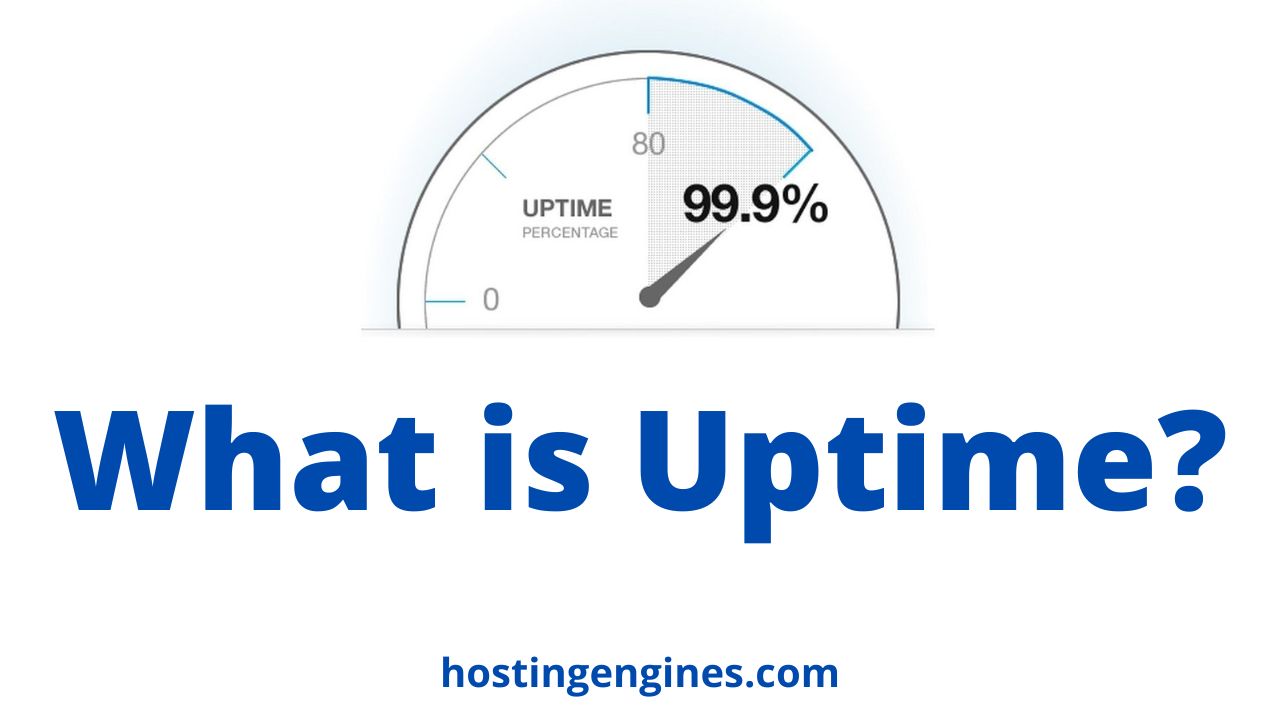One of the most important factors that a website owner should consider when applying for web hosting is web hosting performance. Especially Uptime.
If the web hosting company has a bad uptime percentage, it means that the websites that you are going to host on it will probably go down and crash several times. And vice versa.
When you think about it, your website is your business. If a website is down, then your business is not bringing in any money also, uptime is the key to a good customer experience.
You definitely don’t want to deliver bad signals to visitors when they visit your website. That’s why we are here to help you understand what is Uptime and what are the best providers for this cause.
What is Uptime?
Uptime refers to the percentage of time that the server is up and your website is available. It’s a term used to describe how long a service has been available without any problems or interruptions.
A service can be anything from a website to an app, and it can be measured in seconds, minutes, hours, days, weeks, or months.
A website with high uptime is accessible to visitors. for example, if a web hosting uptime is 99,9% that means it’s down for :
- 14 minutes and 24 seconds per day.
- 7 hr and 12 minutes per month.
- 3 days, 14 hr, and 24 min per year.
So if you want to choose a web hosting provider the uptime percentage must be high enough, 99% or higher to ensure that your website is up and running and has fewer downtimes.
Why uptime is important?
Uptime is essential, it can be the difference between a successful and unsuccessful website. Uptime is not just about outages, but also about the time the website is available to visitors.
During downtime, visitors will have to go elsewhere to get what they need. The shorter the downtime, the better the experience for the visitor. The ideal is to have no downtime at all, but it is not always possible to achieve.
When a website is down, it is not just a headache for the person who owns the website but a major inconvenience for the people who use it.
If the website is down for a long period, it can cause serious damage to the website or the business’s reputation and the user’s trust in the company. That’s why web hosting companies need to have excellent uptime.
How to Calculate Uptime?
To ensure that your website is running properly, you should know how the web hosting uptime is measured. Web hosting Uptime can be measured by checking the system’s status or the server monitor during the peak hours in a given time It is usually written in a percentage.
This can be calculated by taking the amount of time that a server has been up in a specific time and dividing it by the total amount of time in a specific period.
This can be done by using the following formulas:
Uptime = total time – the downtime.
Web hosting uptime percentage = Uptime / total time × 100
For example: If a server has been offline for 30 minutes over 3 days. The uptime will be calculated as:
The total time in minutes = 3×24×60 = 4320 minutes.
The web hosting uptime in minutes = 4320 – 30 = 4290 minutes.
The web hosting uptime percentage = Uptime / total time × 100 = 2860 / 2880×100 = 99,3%
So the web hosting uptime percentage is 99,3%
You can use our Uptime calculator tool to automate this process.
99.9% Uptime vs. 99.99% Uptime
A 99.9% uptime might sound impressive, but what does that mean in real terms?
- 99.9% Uptime: Your site could be down for about 43 minutes in a month.
- 99.99% Uptime: Your site could be down for about 4 minutes in a month.
It’s essential to consider what level of downtime is acceptable for your business.
How to Monitor Website Uptime?
Uptime monitoring is an important part of web hosting. Without monitoring your website uptime, you won’t be able to know if and when your website goes down.
Some web hosting providers like Cloudways provide a real-time monitoring system for their servers. However, the best way to monitor uptime is by using a monitoring tool such as Uptime Robot.
The uptime monitoring tools will allow you to monitor your website’s uptime status.
Factors to Consider When Evaluating Web Host Uptime
- Service Level Agreement (SLA): Always check the SLA of a hosting provider. It provides a commitment regarding uptime. For instance, a 99.95% SLA uptime means a potential downtime of 4.38 hours a year. To check a web host’s uptime search it on Google. For instance, search for “Hostinger Uptime” when checking Hostinger uptime.
- Redundancy: Make sure that the hosting provider has redundant systems in place. This means backup servers and power supplies to switch to in case of failures.
- Monitoring & Support: A good hosting provider continuously monitors servers and has a responsive support team ready to address issues.
- Past Performance: Consider looking at reviews or third-party monitoring tools to assess a provider’s historical uptime performance.
Service Level Agreement (SLA):
Always check the SLA of a hosting provider, it provides a commitment regarding uptime. For instance, a 99.95% SLA uptime means a potential downtime of 4.38 hours a year.
Redundancy and Reputation:
Make sure that the hosting provider has redundant systems in place. This means backup servers and power supplies to switch to in case of failures.
Monitoring & Support: A good hosting provider continuously monitors servers and has a responsive support team ready to address issues.
Past Performance: Consider looking at reviews or third-party monitoring tools to assess a provider’s historical uptime performance.
What is downtime?
Downtime is the time when your website is unavailable. When you are hosting your website or web application, downtime can cause your visitors to leave and your business to lose money.
As a result, it is important to identify the causes of downtime so you can take the steps to solve the problem.
What are the causes of downtime?
The cause of website downtime can be attributed to many factors. The causes of website downtime can be as simple as a software update, a hardware failure, or even a power outage.
- Human errors: Human errors are a common cause of downtime. They can be caused by anything from forgetting to install the latest software update on the server, to human error in entering data, to human error in using incorrect commands.
- Software failures: Operating system failures are also a common issue for websites as they often rely on an operating system that needs to be updated regularly with security patches and bug fixes.
- Hardware failures: This is the most common cause of websites going offline. A number of hardware failures can cause website outages if not dealt with quickly and efficiently.
- Network connection issues: Network connectivity issues are often caused by poor or outdated network cabling, switches, routers, and other networking equipment
- DDoS attacks: DDoS attacks are a type of cyberattack that are used to disrupt service availability or to make services unavailable.
Even though the cause of the downtime, whether it is hardware, software, or server-related, can be identified and fixed, sometimes it can be difficult to identify which cause of the downtime.
If the cause is software, then you can look into upgrading your software, or you can look into setting up a backup system.
If the cause is hardware, then you have a few more options. You can either upgrade your hardware, or you can look into a different hosting company.
What are the problems that downtime causes?
There are many issues that might happen to your website if you face a series of downtime issues, but there are two major problems to be considered the most important ones. They are:
Uptime affects user experience:
Uptime is a major factor that affects the visitor’s experience. It is important for the website to be up and running all the time so that it can provide its services to visitors.
You don’t want to let your customers find your website down and can’t be accessible for any reason, so they won’t come back again. If a site is down, it can hurt the brand and lead to lost revenue.
A recent study found that downtime costs businesses up to $3.5 billion per year and reduces their ROI by up to 30%.
If a website is down, visitors will likely find other alternatives to use while they wait for it to come back online.
Uptime affects search engine optimization (SEO):
Search engine optimization is all about making your website as visible to search engines as possible. Search engines like Google use the uptime of a web host to determine how reliable your site is.
The more often your website is up and being used, the more pages will be indexed by the search engines, and the more often you will be listed in search engines.
Search Engines care much about the human traffic that they get. If your website is down occasionally for any reason, it’s more likely that search engines won’t rank your website for visitors.
If your website goes down, Google will not index your missing content, and search engines will not be able to find your website. So You will not be able to rank as high or show up in search engine results.
Eventually, your website will lose most of its traffic.
This can be very frustrating for a business owner who relies on the internet to make their business successful. That’s why you should consider applying for really a great web hosting provider with great uptime.
How do I avoid downtime?
Downtime is unavoidable in the workplace. It can happen when you least expect it and without any notice. You might be doing your work, but suddenly you realize that you are not getting anything done because of a power outage or your server crashing.
Here are some ways to avoid downtime:
- Sign up for a good web hosting provider that has great Uptime.
- Use cloud hosting such as Cloudways. Cloud hosting creates a cluster copy of your website and stores it on different servers. So when your website goes down, a copy of your website will save the day.
- Use CDNs. CDNs are used by websites to improve their performance by distributing their content across multiple servers in different locations, increasing reliability, and scalability, and reducing latency.
- List your websites on an Uptime monitoring tool and set up alerts for when websites are .unavailable
Uptime monitoring types
There are many types of monitoring types, here are the most important:
Ping monitor:
Ping Monitor is a great tool for uptime monitoring. The ping monitor tool is simple and easy to put into place on your website. This tool provides real-time information on how well your website is performing.
Ping Monitor can be used to keep an eye on the status of your servers. ping monitor pings your website to see if it responds and find out what it is doing.
You can use the ping monitor to see how long your servers have been down and to know if there are any issues. It sends you an email or text when your servers are down.
But its main drawback is that it only checks whether the website is accessible or not and does not give any information about the connection speed.
HTTP monitor:
An HTTP monitor is used to watch the HTTP traffic coming in and out of your site. This helps you make sure that your website is up and running, and that your visitors can successfully reach the site
It will also let you know when your server goes down. The HTTP monitor is easy to use, and you’ll be able to check your server status in no time. They will also show you how long it has been down, and provide you with a list of the pages that are down. You can also use this tool to see the load time for your website.
DNS Server Monitor:
A DNS Server is a server that translates the domain name into an IP address. DNS Server Monitor One method for monitoring website uptime and a great tool for monitoring DNS servers and keeping them healthy. It works by checking the records from the DNS server.
This is a free tool that allows you to check if a website is online or offline. It will also tell you if your DNS server is using too much or too little memory.
TCP port monitors:
TCP port monitor is a tool used to monitor the Transmission Control Protocol and informs you if there are any failures.
It will let you know if your website is down, and you’ll be able to track down the source of the problem and fix it without having to call your web developer. It’s a quick and easy way to check your website’s performance.
When used correctly, a TCP port monitor can give you a view of what is happening on your website.
What is an uptime guarantee?
The uptime guarantee that a website has is one of the most important factors in choosing a web host. When you choose a web host, you need to ask about their uptime guarantees.
An Uptime Guarantee is a service contract in which a company agrees to provide a certain level of service or product to its customer.
In the case of websites, an Uptime Guarantee promises that the website will be available for use at all times. With this guarantee, companies are able to reduce their chances of losing customers due to downtime.
If a web hosting company offers a 99.99% uptime guarantee, that means if they fail to deliver this percentage, they will give you a refund for every time your server or website goes down more than 0.01%.
It is important to note that the uptime guarantee is not an exact measure of how long a website is up. Instead, it is a measure of how often a website is up, but not necessarily goes down for various reasons, such as a power outage or a server crash.
Best web hosting providers that deliver a stunning Uptime
There are many web hosts that offer a solid 99.99% uptime. Based on what you want, I will share with you the best web hosting services that offer the best uptime guarantee.
For small website owners who want to host their websites on shared hosting for less than $3 per month, Bluehost offers 99.98% uptime.
For small business owners who want their website to perform very well on managed cloud hosting for just $10 per month, I consider Cloudways to be the best choice.
If you already have a great amount of traffic and you want to scale up more with dedicated resources and servers, Vultr offers a 100% uptime guarantee.
Uptime: The Conclusion
Web hosting is a critical service for any website. All businesses, regardless of their size, depend on it for their success.
It is important to have a web hosting company that has the resources and the technology to provide 24/7 uptime.
A web hosting company with 24/7 uptime can help avoid downtime and keep your website up and running at all times.






